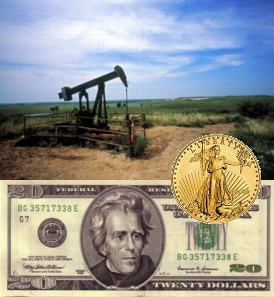 |
by Eric Janszen
Part I: Peak Cheap Oil
While we’ve been bringing on hundreds of welcomed new members these past few weeks, we’re also aware that we’ve perhaps been boring our regular members silly with all of these interviews and rehashing of old news. Time to lay out iTulip’s summary editorial position on oil and the future of oil prices as the US recession that started Dec. 2007 deepens and the dollar enters its next stage of depreciation. Next we’ll rip into the latest gold bashing article from the mainstream business press. Finally, we offer up an anonymous interview with the president of a top 1% hedge fund that has turned each $1 invested in 2002 into $26 today by investing in junior gold mining companies–not only the gold miners themselves but “picks and shovels” firms, too.
First, a brief note for our new readers about our methodology. We are not experts in oil or gold. We are, however, experts in rounding up sources who are experts and at doing analyses on the information they give us over long periods of time (we’ve been at this since 1998) to make reasonably accurate forecasts. Some of those experts are among us, but of course the identities of members and many of our sources that wish to remain anonymous are always kept confidential, including the subject of today's interview.
Peak Cheap Oil
We don’t believe in Peak Oil, the idea that oil will be used up at an increasing rate until one day it’s all gone. When the US ran out of easily (read: cheaply) accessed, high grade crude we shifted to overseas supplies in the 1970s. As those start to run out, where do we go, the moon? No, price will ration supply: we will experience Peak Cheap Oil. Prices will steadily rise. We may already be there.
As we first pointed out in Energy and Money in May 2006, “Inflation is not only determined by the supply of goods available relative to the supply of money to buy them, but also the demand for the currency in which goods are priced relative to the supply of that currency. It can be hard to tell which factor is primarily driving prices.” Here's my latest take on oil prices and the dollar since the major price increases began in 2003 and where I think we are headed.
1. Dollar price of oil rising faster than demand. Global oil dollar prices have been rising far faster than demand for barrels of oil as measured by the OECD since 2004.
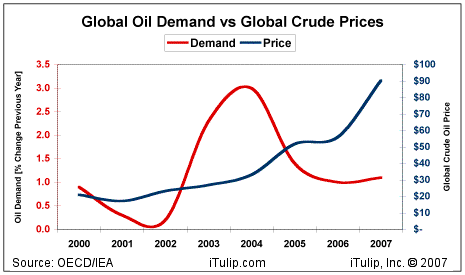
2. Dollar price of most commodities have been rising. The dollar price of nearly every kind of commodity, from foods to metals, has also increased in price at rates that are in most cases a multiple of demand growth.
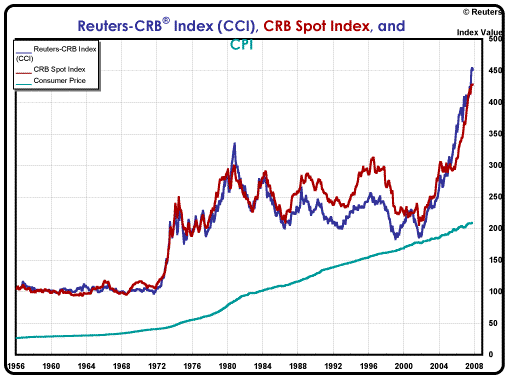
3. Dollar price of most commodities has been rising independent of supply/demand characteristics. If you break that chart down into its component parts, you see dozens of commodities going up in dollar price more or less at the same time and extent. Commodity prices are largely driven by supply and demand. The supply and demand characteristics of all commodities cannot be such that they all share the same price timing. Logically, a price factor common to all of them must be influencing the price of all commodities. The most obvious choice is the dollar money supply.
4. Euro price of oil up only modestly. As evidence of this, note that oil priced in euros has also increased over the same period but only modestly.
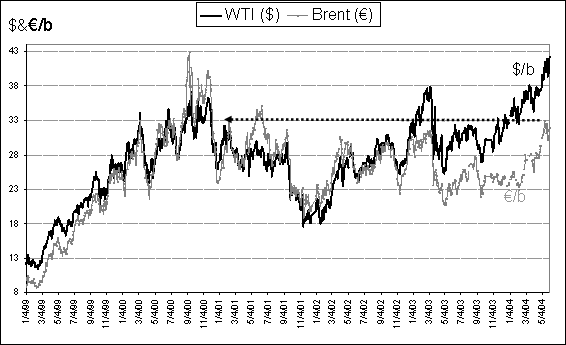
5. Currency depreciation. During the period, the dollar has depreciated by over 30%.
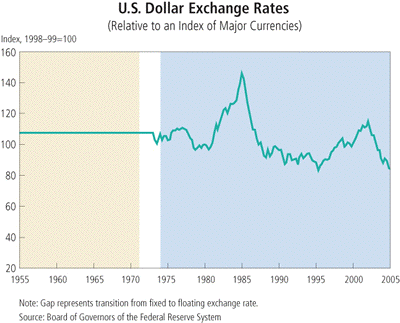
The US has used currency depreciation since 2003 as its primary economic policy tool. The objectives are to promote exports both to boost economic growth and to reduce the trade deficit.
The result has been a temporary boost in exports, a delay in the hard landing we would have otherwise experienced in 2007, but no decrease in the merchandise trade deficit. Last point first.
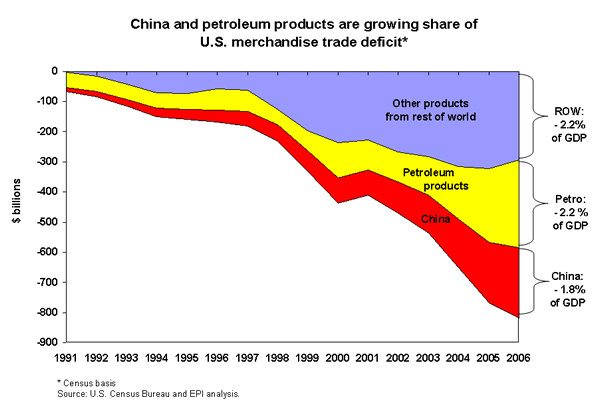
Now the US enters a major recession with a weak currency, large trade and fiscal imbalances, and huge entitlement liabilities. Demand for oil will decline, but the dollar will decline faster as the government comes to the rescue. The only mystery we will all have trouble solving over the next few years is whether higher oil prices are resulting from a diminishing supply of cheaply extracted oil–Peak Cheap Oil–or from an over-supply of dollars, Peak Dollar. Which brings us to our next topic: has gold gone too far too fast as a dollar depreciation indicator or is it just getting started?
Part II – More Lame Gold Bashing by the Mainstream Business Press
The front page of the Personal Investing section of today’s Wall Street Journal writer Eleanor Laise warns readers to not jump into the gold market. The article starts off this way.
How to Survive the New Gold Rush
Investors Race Into the Hot Commodity, Even as Advisers
Warn That Gains May Have Peaked; Beware the Tax Hit
Gold has been riding its reputation as a safe haven to new highs. But it also carries substantial risks for investors.
With fears of a U.S. recession prompting investors to abandon stocks, the Dow Jones Industrial Average is down 6.6% so far this year. Gold, meanwhile, has been hitting new records. The precious metal has gained 11% this year, to $927.10 an ounce, and has soared 46% since the end of 2006. As the dollar weakens and the economy and markets appear increasingly unstable, some market watchers believe the metal is now headed to $1,000 an ounce.
Really? $1,000? I went on record in 2001 when gold was dead and trading at $265 saying gold may reach $2,500 an ounce, eventually. Old timers with long track records picking tops and bottoms in the gold price like Jim Sinclair over at JS Mineset are calling for $1,650 this year. Investors Race Into the Hot Commodity, Even as Advisers
Warn That Gains May Have Peaked; Beware the Tax Hit
Gold has been riding its reputation as a safe haven to new highs. But it also carries substantial risks for investors.
With fears of a U.S. recession prompting investors to abandon stocks, the Dow Jones Industrial Average is down 6.6% so far this year. Gold, meanwhile, has been hitting new records. The precious metal has gained 11% this year, to $927.10 an ounce, and has soared 46% since the end of 2006. As the dollar weakens and the economy and markets appear increasingly unstable, some market watchers believe the metal is now headed to $1,000 an ounce.
This gold bashing article is one of hundreds like it that I’ve read since 2001 when we recommended gold as a hedge against irresponsible government spending and monetary mismanagement. These articles all more or less stick to the script that Laise follows with her four bullet points. I shoot them down, below.
• Gold has lately been hitting record highs, but it comes with substantial risks for small investors.
Not so. The risks of gold investing are no greater or less than for any other investment. Are we supposed to believe that investing in bonds is “safe” with the Fed raising interest rates in panic mode? Do you like investing in TIPS when the CPI inflation rate they are based on appears to be cooked? How about owning stocks as the US is in the early innings of a debt deflation, the likes of which are still haunting Japan’s economy more than 18 years after their debt deflation started? I summarize the Debt Deflation Bear Market here.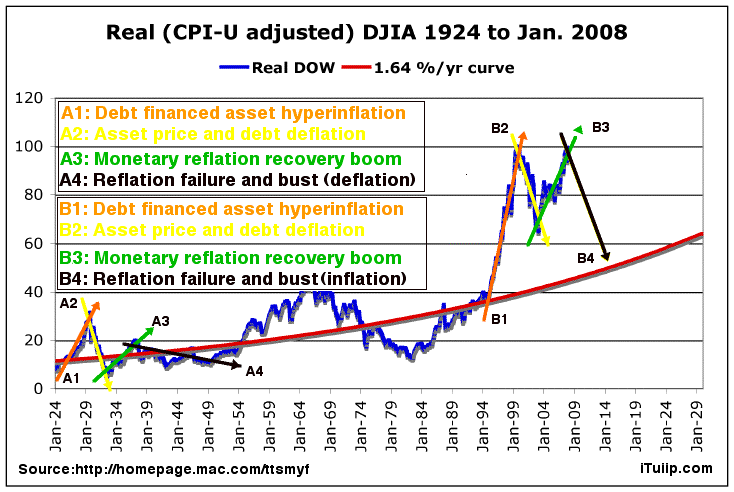
The US debt deflation will result in a very weak dollar, which is inflationary. It is how the DOW/Gold ratio returns to 1:1, in case you were wondering.
On to the second fallacious point.
• Pure-play gold investments can be extremely volatile.
“Can” be volatile, but please don’t mention that for the past six years gold investments “have not been” volatile and never, ever compare gold to the DJIA since 2001.
Which was more volatile? Which provided better returns? Gold. When will we read about that in the WSJ? Next.
• Though it's seen as a hedge against rising prices, gold hasn't always kept up with inflation -- and it can wreak havoc on your tax bill.
That’s true. Gold is taxed as a “collectible” at a rate of 35% on capital gains–even a gold ETF. But why? Why can’t I take out a $250,000 loan, buy gold and write the interest off against my income taxes every year for 30 years the way I can with a home mortgage? Why can’t my wife and I pocket $500,000 in gold capital gains profits tax free every two years the way we can with our primary residence? Why can’t I take out an interest only ARM with a nutty teaser rate to buy gold? Why not pay 15% on long term capital gains as on a stock? Wonder what might happen to the price of gold if these tax benefits were suddenly put in place. Think maybe the gold price might go up? Wonder which asset the government wants US citizens to own? (Hint: Not the one that is a bet that incompetent fiscal and monetary management will result in high inflation.)
• Broadly diversified funds that hold a wide range of commodities, including gold, may be a better bet for investors, advisers say.
Gold is a metal so it is in a literal sense a commodity like copper or nickel. But that’s like saying cats are food because they’re animals. Cats have one very special quality that makes them not food: cats are kept by humans as pets. We have conferred upon them a special value as companions and discounted their value as a meal to zero. Similarly, gold is not a commodity because it is the only metal held as a reserve asset by central banks. This fact is conveniently forgotten by most business writers who fail to ask the obvious question: if gold no longer has any value as a backing for currencies, why do central banks still own 20% of all the gold that has ever been mined 37 years after it was ostensibly de-linked from all currencies? The reason is that central banks know that the incompetent, spendthrift governments they are loosely shackled to will continue to pursue inane policies and that these, in addition to their own irresponsibility such as interest rate policies under the Greenspan Fed, will eventually cause their fiat currencies to lose substantial value or worse so they’d better have something to fall back on. That was one of the reasons we recommended it in 2001 and we have not seen any compelling evidence to change our minds. As gold increased from $260 then to $924 today, what do you suppose has happened to the value of central bank gold reserves? You can bet the central banks aren’t complaining.
Part III: Peak Gold?
Today I interviewed the president of a hedge fund that invests in gold by investing in junior mining companies. Not only junior mining companies, but also mining equipment companies, so-called “picks and shovels” stocks.
The fund is in its 6th year and clearly caught the gold wave early and played it well. How well? A dollar invested at inception is $26 today. The fund has been in the top 1% since inception.
EJ: Why is gold going up?
HF: Because all currencies are going down. Have been for a while. A few funds are buying gold. That's it.
EJ: Do you see the US economy going into recession? How will that impact gold?
HF: Yes. The conclusions are so obvious that most people can’t believe it. The die is cast. It’s Argentina early 1990s and UK 1960s all over again. Things will get worse and worse. We’ll have alternating booms and bust with inflation for a decade. Peak Gold? ($ubscription) interview continued...
Note: This article may be reprinted in its entirety including the link above.
iTulip Select: The Investment Thesis for the Next Cycle™
__________________________________________________
To learn about the Next Bubble, sign up for one year of iTulip Select by January 31 and receive the February 2007 issue of Harper's Magazine with Eric Janszen's cover article The Next Bubble free.
For the safest, lowest cost way to buy and trade gold, see The Bullionvault
To receive the iTulip Newsletter or iTulip Alerts, Join our FREE Email Mailing List
Copyright © iTulip, Inc. 1998 - 2007 All Rights Reserved
All information provided "as is" for informational purposes only, not intended for trading purposes or advice. Nothing appearing on this website should be considered a recommendation to buy or to sell any security or related financial instrument. iTulip, Inc. is not liable for any informational errors, incompleteness, or delays, or for any actions taken in reliance on information contained herein. Full Disclaimer
Comment